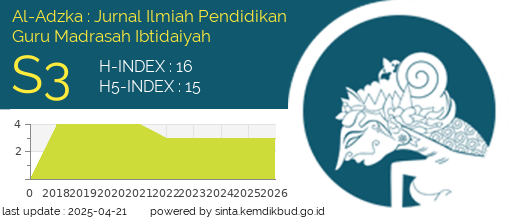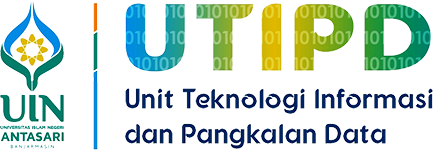Implementation of Blended Learning Model Through Wordwall Application in Improving Critical Thinking of Islamic Elementary School Students
DOI:
https://doi.org/10.18592/aladzkapgmi.v13i2.10880Keywords:
Blended Learning, critical thinking, Islamic Elementary School, wordwallAbstract
A less enjoyable teaching and learning process results in a decrease in critical thinking skills and student learning outcomes. The related impact can be resolved through action research which aims to improve the critical thinking skills and learning outcomes of students by utilizing blended learning with word wall application. This study uses a quantitative research approach with a class action research method. The subjects in this study were all grade VI (six) Madrasah Ibtidaiyah students totaling 35 students. The instruments used in this study used observation sheets with the aim of getting news related to teaching and learning activities, rubrics used to measure students' critical thinking skills, and tests with the aim of measuring students' learning outcomes. The data analysis technique used is the percentage technique to see the percentage picture of students, categorical to classify data, and comparative to compare data results. The results of this study obtained several findings including : 1) students' critical thinking increased, with a vulnerable average score of students' critical thinking ability level from Cycle I to Cycle II of 11.35 points; 2) the average student learning outcomes increased, with a score difference from Cycle I to Cycle II of 10.11 points. While the percentage of classical learning completeness increased, with a percentage difference of 22.85%. So based on these results, it can be concluded that the application of the blended learning model on the wordwall application can make learning more fun, so that it has implications for increasing students' critical thinking.References
Adi, S., & Fathoni, A. F. (2019, November). Development of Learning Model Based on Blended Learning in Sports School. 8–12. Atlantis Press. doi: 10.2991/acpes-19.2019.2
Adje, M., Steinhäuser, J., Laekeman, M., Rogan, S., & Karstens, S. (2023). Evaluation of a blended learning approach on stratified care for physiotherapy bachelor students. BMC Medical Education, 23(1), 545. doi: 10.1186/s12909-023-04517-5
Aidah, N., & Nurafni, N. (2022). analisis penggunaan aplikasi wordwall pada pembelajaran ipa kelas iv di sdn ciracas 05 pagi. pionir: jurnal pendidikan, 11(2). doi: 10.22373/pjp.v11i2.14133
Depdiknas. (2003). Undang-Undang Republik Indonesia Nomor 20 Tahun 2003 tentang Sistem Pendidikan Nasional, Bab I Pasal 1. Zitteliana, 18(1).
Griselda, V. E. (2021). Peningkatan Computational Thinking Guru Dalam Menghadapi Blended Learning. Jurnal Pendidikan Sains Dan Komputer, 1(01), 56–61. doi: 10.47709/jpsk.v1i01.1291
Hapsari, S. A., & Pamungkas, H. (2019). pemanfaatan google classroom sebagai media pembelajaran online di universitas dian nuswantoro. wacana: Jurnal Ilmiah Ilmu Komunikasi, 18(2). doi: 10.32509/wacana.v18i2.924
Hermiyanto, D. L., & Wahyudi, W. (2022). Pengembangan Media Pembelajaran Pomewall (Media Pop Up dan Game Wordwall) untuk Pembelajaran Siswa Kelas V di Sekolah Dasar. JIIP - Jurnal Ilmiah Ilmu Pendidikan, 5(11), 4644–4648. doi: https://doi.org/10.54371/jiip.v5i11.1104
Keshavarz, M., & Yuan, L. (2023). A Narrative Case History of Distance Education Before, During, and After COVID-19 in China and Iran. Canadian Journal of Learning and Technology, 49(1), 1–15. doi: 10.21432/cjlt28275
Lane, S., Hoang, J. G., Leighton, J. P., & Rissanen, A. (2021). Engagement and Satisfaction: Mixed-Method Analysis of Blended Learning in the Sciences. Canadian Journal of Science, Mathematics and Technology Education, 21(1), 100–122. doi: 10.1007/s42330-021-00139-5
Lubis, A. P., & Nuriadin, I. (2022). Efektivitas Aplikasi Wordwall untuk Meningkatkan Hasil Belajar Siswa dalam Pembelajaran Matematika Sekolah Dasar. Jurnal Basicedu, 6(4), 6884–6892. doi: 10.31004/basicedu.v6i4.3400
Mahrus, M., Anggraeni, M. N., & Silmi, I. M. (2022). Pengaruh Authentic Learning Berbasis Lingkungan terhadap Kemampuan Berpikir Kritis dan Pemecahan Masalah IPA. Terampil: Jurnal Pendidikan dan Pembelajaran Dasar, 9(1), 39–50. doi: 10.24042/terampil.v9i1.11394
Mawardi, M., & Koeswanti, H. D. (2021). PPG Students’ Learning Competency Analysis From Self Regulated Learning Factors. Jurnal Ilmiah Sekolah Dasar, 5(4), 737. doi: 10.23887/jisd.v5i4.40111
Megahed, N., & Hassan, A. (2021). A blended learning strategy: Reimagining the post-Covid-19 architectural education. Archnet-IJAR: International Journal of Architectural Research, 16(1), 184–202. doi: 10.1108/ARCH-04-2021-0081
Mujahidin, A. A., Salsabila, U. H., Hasanah, A. L., Andani, M., & Aprillia, W. (2021). Pemanfaatan Media Pembelajaran Daring (Quizizz, Sway, dan Wordwall) Kelas 5 di SD Muhammadiyah 2 Wonopeti. Innovative: Journal Of Social Science Research, 1(2), 552–560. doi: 10.31004/innovative.v1i2.3109
Muzaini, M. C., Rahayu, R., Rizky, V. B., Najib, M., Supriadi, M., & Prastowo, A. (2023). Organisasi Integrated Curriculum dalam Implementasi Pembelajaran Berbasis Life Skill di Sekolah Dasar. Jurnal Paedagogy, 10(2), 598–612. doi: 10.33394/jp.v10i2.7369
Nadia, A. I., Afiani, K. D. A., & Naila, I. (2022). penggunaan aplikasi wordwall untuk meningkatkan hasil belajar matematika selama pandemi covid-19. Jurnal Teknologi Pembelajaran Indonesia, 12(1), 33–43. doi: 10.23887/jurnal_tp.v12i1.791
Novyanti, N., Dewi, H. I., & Winata, W. (2022). pengembangan media pembelajaran interaktif berbasis aplikasi wordwall untuk meningkatkan kreativitas kognitif anak pada pelajaran bahasa inggris. Instruksional, 4(1). doi: 10.24853/instruksional.4.1.%p
Nurafni, & Ninawati, M. (2021). Efektivitas Penerapan Aplikasi Linktree dan Wordwall Terhadap Motivasi Intrinsik Siswa Kelas V Sekolah Dasar. Jurnal Pemikiran Dan Pengembangan Sekolah Dasar (JP2SD), 9(2), 217–225. doi: 10.22219/jp2sd.v9i2.17317
Nussbaum, M., Barahona, C., Rodriguez, F., Guentulle, V., Lopez, F., Vazquez-Uscanga, E., & Cabezas, V. (2021). Taking critical thinking, creativity and grit online. Educational Technology Research and Development, 69(1), 201–206. doi: 10.1007/s11423-020-09867-1
Oktaviana, D., Barizi, A., & Yaqin, M. Z. N. (2022). The Challenges of The Society 5.0 Era: The Evaluation of Learning in Primary Education. Al-Adzka: Jurnal Ilmiah Pendidikan Guru Madrasah Ibtidaiyah, 12(1), 10–17. doi: 10.18592/aladzkapgmi.v12i1.5831
Pradani, T. G. (2022). Penggunaan media pembelajaran wordwall untuk meningkatkan minat dan motivasi belajar siswa pada pembelajaran IPA di Sekolah Dasar. Educenter : Jurnal Ilmiah Pendidikan, 1(5), 452–457. doi: 10.55904/educenter.v1i5.162
Puspitarini, D. (2023). Peningkatan Keaktifan dan Hasil Belajar PPKn melalui Discovery Learning Berbantuan Aplikasi Wordwall Games. Ideguru: Jurnal Karya Ilmiah Guru, 8(3), 388–396. doi: 10.51169/ideguru.v8i3.485
Rahma, T. K., Nurcahyo, A., Ishartono, N., Setyaningsih, R., Setyono, I. D., Putra, D. A., & Fitrianna, A. Y. (2023). Using wordwall as a gamification-based mathematics learning material to support students’ learning activities. 020043. Chennai, India. doi: 10.1063/5.0141610
Saputri, D. D., Fatih, M., & Alfi, C. (2023). Pengembangan Soal Evaluasi melalui Game Wordwall untuk Meningkatkan Disiplin dan Tanggung Jawab Siswa. Edukatif : Jurnal Ilmu Pendidikan, 5(2), 1288–1300. doi: 10.31004/edukatif.v5i2.5054
Silva, H., Lopes, J., Dominguez, C., & Morais, E. (2022). Think-Pair-Share and Roundtable: Two Cooperative Learning Structures to Enhance Critical Thinking Skills of 4th Graders. International Electronic Journal of Elementary Education, 15(1), 11–21.
Stieglitz, V., Buggenhagen, H., Strelow, K.-U., Schmidtmann, I., Skala, C., & Kurz, S. (2023). Action competence in obstetric emergencies—can this be achieved via e-learning? Interprofessional blended learning module on diagnostics and emergency treatment of shoulder dystocia. BMC Medical Education, 23(1), 350. doi: 10.1186/s12909-023-04335-9
Sukma, K. I., & Handayani, T. (2022). pengaruh penggunaan media interaktif berbasis wordwall quiz terhadap hasil belajar ipa di sekolah dasar. Jurnal Cakrawala Pendas, 8(4), 1020–1028. doi: 10.31949/jcp.v8i4.2767
Syamsuddin, S. (2021). dampak pembelajaran daring di masa pandemic covid-19 terhadap motivasi belajar siswa sd inpres 1 tatura kota palu. Guru Tua : Jurnal Pendidikan Dan Pembelajaran, 4(1), 45–50. doi: 10.31970/gurutua.v4i1.65
Tathahira, T. (2020). Promoting students’ critical thinking through online learning in higher education: Challenges and strategies. Englisia: Journal of Language, Education, and Humanities, 8(1), 79–92. doi: 10.22373/ej.v8i1.6636
W, E. R., Rochmad, R., & Waluya, S. B. (2018). Penilaian Kinerja Sebagai Alternatif Untuk Mengukur Kemampuan Berpikir Kritis Siswa. PRISMA, Prosiding Seminar Nasional Matematika, 1, 522–530.
Wulandari, F., Megawati, F., Tirtoni, F., Abrianto, B., & Rahayu, F. F. (2022). Learning Innovation Training Using Quizizz Based Google Meet for Elementary School Teachers: Procedia of Social Sciences and Humanities, 3, 632–636. doi: 10.21070/pssh.v3i.215
Downloads
Published
How to Cite
Issue
Section
License
Copyright (c) 2023 M Choirul Muzaini, Noptario Noptario, Nurul Arifin

This work is licensed under a Creative Commons Attribution 4.0 International License.
Authors who publish with this journal agree to the following terms:
- Authors retain copyright and grant the journal right of first publication with the work simultaneously licensed under a Creative Commons Attribution 4.0 International that allows others to share the work with an acknowledgement of the work's authorship and initial publication in this journal.
- Authors are able to enter into separate, additional contractual arrangements for the non-exclusive distribution of the journal's published version of the work (e.g., post it to an institutional repository or publish it in a book), with an acknowledgement of its initial publication in this journal.
- Authors are permitted and encouraged to post their work online (e.g., in institutional repositories or on their website) prior to and during the submission process, as it can lead to productive exchanges, as well as earlier and greater citation of published work.












